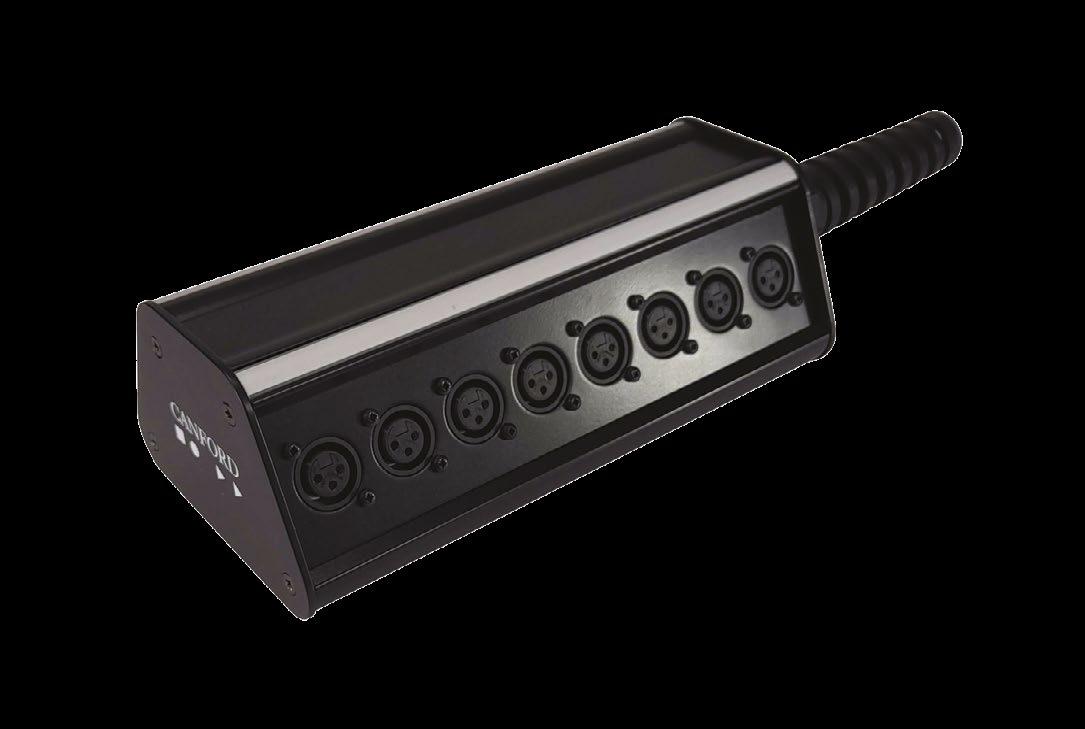
9 minute read
Malvicino Design Group
By Stephen Gallagher, Canford Marketing Manager and Horacio Malvicino, Managing Director of Malvicino Design Group
Longstanding Canford customer Malvicino Design Group is a design and consulting firm specialising in innovative architectural, acoustical, and technical systems design. Headquartered in Manhattan, New York, USA with a manufacturing facility in Europe, the company has amassed an unrivalled level of experience in its field.
Founded by Acoustic Designer and System Integrator Horacio Malvicino, who fine-tuned his knowledge while running the technical division at The Hit Factory. A highpressure engineering role that would see the Massachusetts Institute of Technology graduate repairing kit and preparing studios for famous clientele, and where he once simultaneously ran studios for Neil Young, Bruce Springsteen and Paul Simon.
Malvicino Design Group has completed in excess of 300 projects around the globe. The skilled team has truly established the firm as industry leaders. The company has an enviable résumé which includes world-class projects for clients such as Sony Music Studios – Miami and Capitol Studios – LA, alongside customised solutions for Whitney Houston, Celine Dion, Steely Dan, Alicia Keys, the Scissor Sisters and Sting to name just a few. Beyond recording studios and postproduction workspaces Malvicino Design Group delivers facilities for broadcasters around the world. Broadcast projects have included a TV studio overlooking the Giza Pyramids in Cairo for ART. Another memorable project commissioned by Sony saw Malvicino lead his team to Iraq. The team would deliver a recording facility and post production rooms for Iraq Radio and Television. Described by Horacio as ‘an interesting place to go’, where site visits involved flights that would dip and dive to avoid incoming RPG fire! In an exclusive Q&A for Canford’s Source Material, Canford Marketing Manager Stephen Gallagher caught up with Horacio Malvicino to find out more about the man behind Malvicino Design Group, learn where it all began and ask what the future holds:
Your career, and the work of Malvicino Design Group has been nothing short of impressive. Where did it all begin? Could you provide an introduction for yourself?
My lifelong dream was to become a professional tennis player. I started playing at an early age locally and then travelling to nationals. As you can imagine, it didn’t go that well with my parents. While I was doing pretty good my parents thought that it was a dead end street, so my only option was to give college a try. I come from a family of musicians. My Dad has been a guitar player and mostly made a living scoring orchestras for a vast array of artists. For that reason, I started spending time in recording studios, especially RCA studios (where my Dad was a staff producer for the label) at a very early age. By the late 60’s I was
sleeping under a Neve console regularly. I always had a thing for studios, music (I played drums) and being around the recording process. When the tennis was a no go from my parents, and college was the way they mapped for me, I thought electronics was probably the way to go. I always had a thing for gear, electronics and the studio, so I decided that electronics was going to be a path to freedom!
I understand you studied electronics at Massachusetts Institute of Technology (MIT). How did that come about?
My idea back in high school was to go to school in the US. Since I was a little kid my parents would bring me to the US, and I fell in love with NYC. In the 70’s NYC was a melting pot of music. Jazz clubs everywhere, concerts, pretty much everything that you might want at your fingertips. I started looking for schools to study electronics and came across MIT. It was and still is a great school, completely detached from music, but in a great town (Boston) surrounded by music (Berkley School of Music), so it was the perfect combination. I was a superb student in high school, so with a combination of great grades and some kick ass SAT’s I got in. well as RCA studios were a battlefield test for me. I know a lot of electronics, but the application to all this special gear was a process to be reckoned with. At Soundtrack I was in charge of the whole facility, 8 large recording studios. I learned everything in this place, going in at 6 am to have the studios ready to start recording at 9 am, all studios at the same time - it was a real trip.
Did you always want to get into the music business?
It never crossed my mind becoming a professional musician. I love music, love playing drums and being around the environment, but making a living out of playing music, not my thing.
Already working alongside the biggest names in the business, what led to you forming Malvicino Design Group?
My boss at Soundtrack, Rob Caviccio, is the person that I have to thank for being where I am. At the peak of my job one day he called me into his office and gave me a speech. He basically told me the following: You are at the top of the food chain and at this place, it is as far as you are going to go. I give you three months, put a small company together and start working on your own! He pushed me and even today I am grateful!
What brought you to New York?
When I completed college, companies from all over the US come to MIT to scout for brainiacs. Most of the students get jobs at GE, Siemens, NASA, big technology companies! That was not for me, I am not the type of guy that will work well in a corporate/ engineering environment, so I asked my dad for some leads in recording studios that he had worked in NYC. He gave me a bunch of leads, I took a train back to NYC and started looking for a job where I could apply some of my electronics background.
What were your roles at the Hit Factory and Soundtrack? And what did you learn there?
At The Hit Factory I was a Tech/ Maintenance engineer. My job was basically to set up all the recording sessions. Get all the gear, align tape machines (analogue days), set up all microphones, have the studio ready and tested to start a session. This place as
What do clients get/what should they expect when they come to Malvicino Design Group?
Because of all the time that I spent in studios, I have a full background not only in system integration and installation as well as acoustic design. To our clients, we provide a full service, from designing the space, documenting the acoustic design, developing the system integration, manufacturing all of the wiring and completing the circle by the onsite installation. We are also a global company, which means that we can target projects anywhere in the world, with the same dedication and efficiency.


Can you reference a few headline clients/projects?
Capitol Studios | LA, CA Republic Studios | LA, CA 7 Pillar Studios | Cisco, TX Precision Sound Studio | New York City Soundtrack Recording Studios | Boston, MA Soundtrack Recording Studios | New York City, NY The Magic Shop | New York City, NY Think Loud Studios | York, PA Vanquish Studios | Davie, FL Caracol Television | Bogotá, Colombia El Pie Recording Studios | Buenos Aires, Argentina ESPI 10.29 Studios | Mazatlán, Mexico Green Road Recording Studios | San Jose, Costa Rica La Mansion Recording | Monterrey, Mexico Sonolux Discográfica | Bogotá, Colombia El Alto Studios | Medellin Colombia Studios Mega | Rio de Janeiro, Brazil Tecnologico de Monterrey Studios (Campus Estado de Mexico) | Mexico DF, Mexico Tecnologico de Monterrey Studios (Campus Mexico City) | Mexico City, Mexico Tecnologico de Monterrey Studios (Campus Monterrey) | Monterrey, Mexico Tecnologico de Monterrey Studios (Campus Santa Fe) | Mexico DF, Mexico Televisa Chapultepec Studios | Mexico DF, Mexico TV Globo | Rio de Janeiro, Brazil Valenzo Recording Studio | Mexico City, Mexico Argos Studios | Mexico City, Mexico
I gather you’ve worked in some pretty amazing (and dangerous!) places. Can you tell us a little about the most technically challenging?
We completed a private project for a very high profile client in a private island in Tahiti. This was a real challenge. From sourcing materials around the world, to shipping to the main island (Papete) and then to the small private island by boat.
Horacio Malvicino
How did you discover Canford? What do you buy, and why did you come to Canford?
About 13 years ago, we decided to move all of the studio wiring manufacturing division to Europe. I reached out to my friends at Solid State Logic at the time, Graham Caddy and he was the one that recommended Canford. I reached out
to Canford over the phone, I explained to them the situation and they assigned me to Emma Curtis @ the International Division. The rest is history. 13 years and strong. Emma, Debbie, Vita, the whole team is amazing. This team will bend over backwards for MDG. We buy everything from Canford. Canford custom patchbays are one of the most important items, as all of the installations as well as OEM products that we manufacture for other console manufacturers are based on this product. Connectors (Neutrik, Rean, ITT Cannon, Elco), our complete supply of connectors comes from you guys. Accessories, shrink tubing, labels, and any other items we need to get our projects going.
How have you found the team at Canford? Helpful, friendly, knowledgeable?
I can not imagine our installation business moving forward without Canford. The team is amazing and they do have a complete knowledge of all the products available. I also have a direct line to Gavin, who is a real “guru” when it comes to product and getting things done.
Very occasionally things can go wrong. How do you feel Canford handles this? And are you confident the team has your back?
In all 13 years, we had only one issue with a product that I can recall, and things were corrected immediately, even when the manufacturer decided not to support us. Canford came through.
What’s next for Malvicino Design Group?
Another 13 years with Canford and the team will be great! With the incredible boom that we are seeing with Apple Music and Dolby Atmos, we will be building many studios in the years to come and Canford will be there for us all the way.















